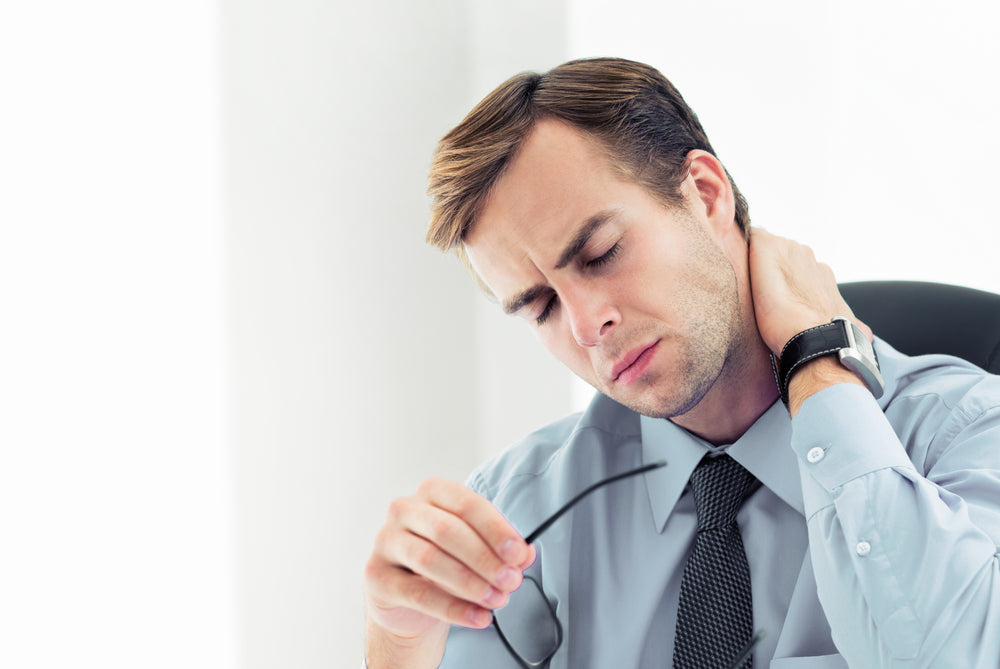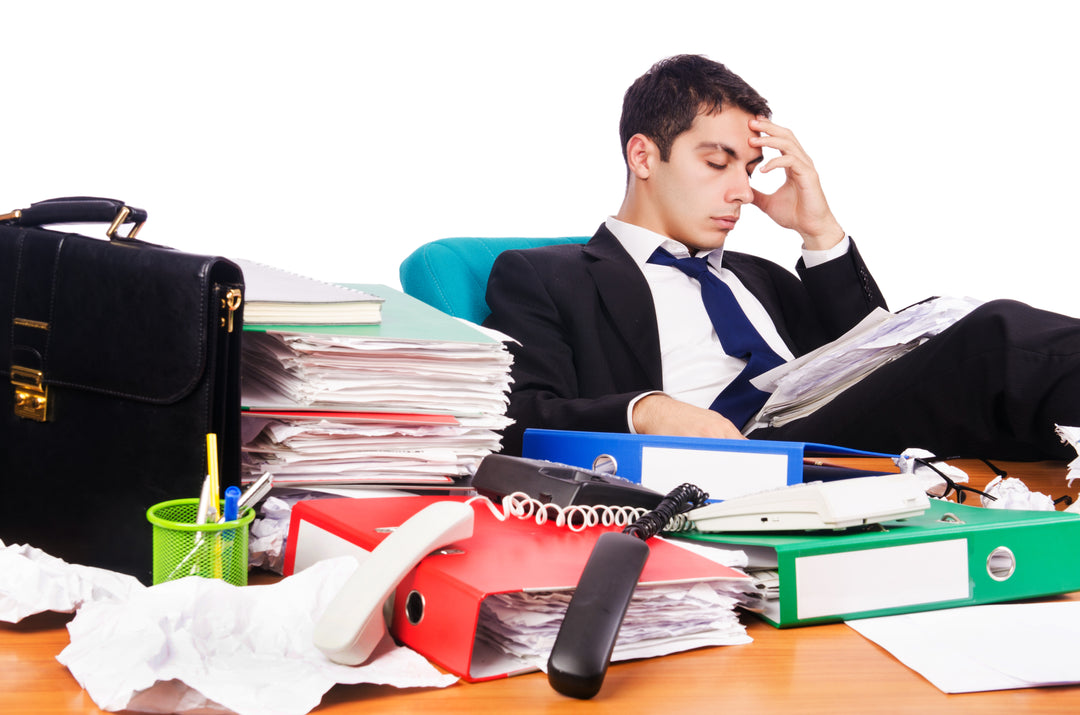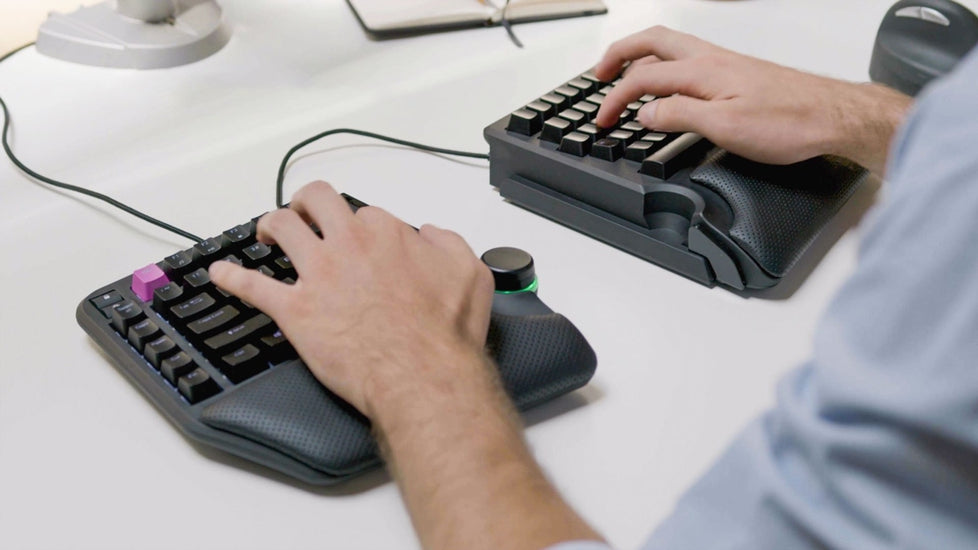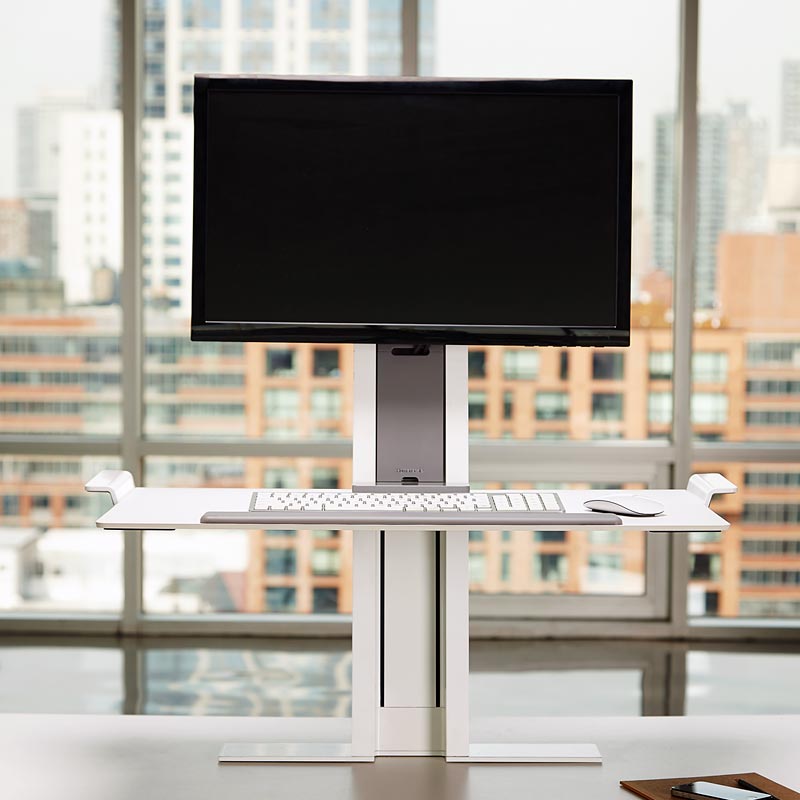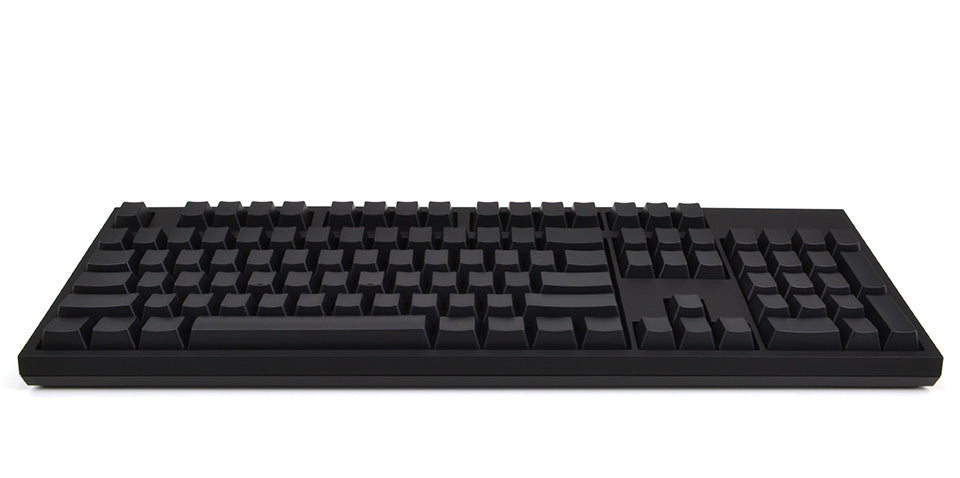You’ve probably heard the phrase “sitting is the new smoking”. A nasty new understanding of how the cardiovascular system works: as it turns out, twelve straight hours of prolonged inactivity isn’t super good for you.
To combat the health problems that can come from sitting all day, a myriad of specialty office equipment has hit the scene designed to specifically to make it comfortable to stand while you work.
Great! Problem solved, right? Not quite. Research is now showing that it is just as bad to stand all day as it is to sit. In fact, the cardiovascular health of people that work constantly on their feet is similar to that of those who smoke.
Damned if you do, damned if you don’t? Not exactly. There actually is a happy medium that can keep you feeling comfortable while also improving your health.
Why Sitting Is Bad For You
Let’s start with sitting. After all, just because standing can be problematic for your health doesn’t mean the answer is to sit on your butt all day.
In fact, excessive inactivity is associated with diabetes, high blood pressure, obesity, and a general heightened risk for cardiovascular problems.
It’s also important to understand that the problem isn’t just the aggregate amount of time that you spend seated each day. In fact, it may be the consecutive minutes that you rack up that wind up mattering the most.
The longer you stay seated, the more your metabolism stagnates and the more exacerbated the risk becomes. As a result, researches strongly suggest that people are well-advised to get up at least once an hour.
Because of the damage that consecutive sitting can do, even regular exercise won’t get you out of this jam. In fact, studies show that people who go to the gym daily are still subject to the same risks as anyone else. If you want to account for all risk factors, there is no way around it: you need to sit less.
Disclaimers
It is worth noting that there are a few other tendencies common to people who have exhibited a heightened risk of early death due to sitting. In many of the larger case studies that have been done on the topic of sitting at work, the participants who were in the high-risk factor group also tended to be older men with a habit of smoking.
Needless to say, these factors also heighten an individual’s risk of heart disease. Still, the association with prolonged sitting and early death is still strong enough to be taken seriously. You may not be able to control your age or gender, but you can control how much time you spend on your butt, so try to get up regularly, even if it’s only to stretch your legs.
The Challenges:
Though the actual solution to prolonged sitting is fairly simple, it’s regrettably not as easy a fix as one might at first assume. To truly correct excessive sitting, an individual must diligently keep track of the amount of time they spend on their butts, versus the time that they spend on their feet.
Similarly, you will also need to make sure that you are tracking how often you get up for your standing breaks. The good news is that modern technology doles make even personal data taking much simpler. There are plenty of apps that allow you to set timers, and keep track of various key analytic points so that you can measure your progress over a prolonged period of time.
A Solution?
So at the start of this article, we mentioned how some people are making the move towards specialty office equipment that makes standing at work infinitely simpler.
Sit/stand desks allow workers the chance to adjust their office equipment so that it is comfortably positioned regardless of whether or not they are on their feet or their rear.
Standing desks have lots of different benefits. In addition to helping you avoid many of the pitfalls associated with prolonged sitting, they also are a great way to help you lose weight while you work. After a day of standing up at work, it’s not impossible for you to burn 750-800 calories every single day.
This means that if you’ve been trying to shed a little bit of weight, you may easily shed up to one extra pound a week just by showing up to your job.
Standing desks are also thought to be more comfortable than those of the traditional variety because they position your spine, wrists, shoulders, and neck in a position that is much more anatomically natural.
Ergonomic office equipment can be somewhat expensive, but the nice thing is that many businesses have special programs through which they will pay for some or all of their employee’s office upgrades. If you would like to improve your workspace with ergonomic equipment, inquire with your manager to see if they have any special opportunities you can take advantage of.
So, that takes care of that. Well, except for one thing…
Standing Might Be the New Sitting:
Let’s just put it right on front street: for as good a thing as getting out of your chair can be, doing so in excess can be catastrophic for your cardiovascular system.
Scientists are now telling us that standing at work can more than double your chance for heart disease.
Here’s why: the longer you stand, the more blood begins to pool in your legs, the more pressure is put on your heart to continue circulating your blood.
The studies that have revealed this new data tracked the issue by profiling thousands of people over a twelve-year period of time. The idea was to profile people with a wide variety of different careers so as to see what lines of work put the greatest strain on heart health.
The study was also broad enough o account for other prominent risk factors such as age, tobacco and alcohol use, and other lifestyle factors that can contribute to heart health.
Even after making allowances for various risk factors, the study still found that jobs requiring the worker to stand were more hazardous to health.
I’ve Been Purposely Trying to Stand More at Work. Am I a Sucker?
Not at all. As mentioned throughout the course of this article, standing at work can be very good for you. It’s a great way to fire up the metabolism, lose weight, and generally offset the various health risks associated with inactivity.
If you are standing at work of your own volition, chances are pretty good that you’re in a healthy place with your sitting to standing ratio. Most likely, you find yourself sitting on occasion throughout the day, whether it be to answer a call, speak with a colleague or take your lunch.
These occasional breaks should be enough to ensure your health, though you may find it to your benefit to monitor the situation to ensure that you are getting off your feet with enough frequency.
Jobs Associated With Heightened Risk
In the case of excessive standing, it is rarely office jobs that are associated with enhanced risk. Rather, the cardiovascular concerns highlighted by the study were found most often in people with jobs that mandate they be on their feet continuously.
These positions include cooks, waiters, people in sales and construction. In certain cases, it makes sense why a worker would need to be on their feet.
For example, in the context of the kitchen, the chef may find themselves sharply limited by a chair. However, there is also a stigma associated with sitting during shift work. If you’ve ever worked as a clerk, or cook, or any other such position, you may have heard uttered from the lips of your tyrant manager a phrase similar to the following: if you have time to sit, you have time to clean/inventory/etc.
The idea here is that sitting is not adequate use of paid company time. Furthermore, many businesses believe that a seated employee promotes an idea of in-attentiveness or even poor customer service.
While standing born of necessity is an ongoing problem, there is perhaps something that can be done about the stigma of sitting for general health reasons. In this instance, awareness is key. As studies continue to highlight the health risks associated with eight straight hours on your feet, the hope is that employers might use this information to create healthier workspaces.
As of right now, there are now laws mandating that this be done. There are disability protections that ensure reasonable accommodations to the differently-abled so that they may better perform the fundamental responsibilities of their job.
In these instances, employees may, in fact, be legally entitled to a seat at work. For the rest of us, workplace changes are no guarantee. If you are worried about how much time you spend on your feet at work, talk to your employer about ways that you can take more breaks.

The Solution to the Solution
So sitting is no good, and standing desks, though good for your waistline, may ultimately be bad for your heart. It sounds like a no one situation right? Well, there are actually a few things you can do: chief among them, perhaps, is to invest in an adjustable desk.
The adjustable desk operates much the same way as that of the standing variety, but instead of being fixed permanently in the standing position, it can be altered to make comfortable for sitting as well.
There are lots of different options for buyers of every budget. Some adjust manually, while other, fancier units even feature digital controls that make changing up the desk configuration as simple as pressing a button.
If you just want to dip your toes in the water, you can even purchase a standing desk booster. These products are basically footstools for your computer equipment. When you want to stand you can setup it up in a matter of seconds. When you want to sit, it can be broken down just as easily.
The sit/stand desk gives you the best of both worlds. All the ergonomic comfort of the standing desk with the much-needed rest of a chair thrown in in regular intervals. Complete the office set up with an ergonomic chair, keyboard, and monitor, and you should find that you feel better than ever at work.
It’s a big lifestyle change, but hey, big changes garner big results.

Best Practices
Setting reminders for yourself to either stand up or sit down (depending on which one you need to do more of) is perhaps the easiest way to mitigate the situation.
However, as with any change to your health regiment, you may find it prudent to sit down with your doctor and see if they have any special recommendations for you based on your own personal health history. Remember that studies are broad, and their recommendations may not be suitable for everyone.
It’s also best practices to simply listen to your body. This is especially true of people who are trying to stand more at work or at home. It may sound silly but you can injure yourself by overdoing it. You don’t want sore feet, or an inflamed knee to keep you chair bound for several weeks.
The solution? Monitor the way that you feel. If standing produces prolonged discomfort, then, by all means, take a seat.
And of course, you also won’t have much luck standing without the proper equipment. While you may not be ready to invest in a new desk just to stand up at work, at least consider propping your computer equipment up with a booster, or hey, even a stack up books so that your monitor is eye level. This will help you to avoid debilitating back/neck pain.

When You’re At Home
The catch 22 of going home is that it is easier than ever to strike an ideal balance between sitting and standing, but also, you probably won’t want to.
Hey, it makes sense. After eight hours at work, another hour or so of commuting, we are all tired. We all want to plop down on the couch with a book or a television show. If this is the way that you unwind at the end of a long day, at least do what you can to make use of the best practices we have mentioned throughout the course of this article.
For example, you may find it easy to remember to get on your feet if you take a short walk every time there is a commercial break, or when you finish a chapter in your book.
It’s also important to exercise regularly. Striking the balance between sitting and standing is great, but it is no substitution for the thirty minutes to an hour of exercise a day that doctors recommend.
If Your Job Keeps You On Your Feet
We talked earlier about petitioning your boss for changes that would allow you to spend more time off your feet. However, in certain cases, this simply will not be possible.
If you work a job that demands you to be on your feet all day, you still need to find ways to take short breaks. It’s important that you listen to your body. If your feet, legs or back begin to ache, view this as a sign that it is time to take a short rest.
Brief but regular sitting breaks aren’t just good for your health, but they are also good for productivity. A healthy worker is an efficient worker, so don’t hesitate to take breaks when you need them.
If your manager is making it difficult for you to take sitting breaks, you may be able to take brief respites in the bathroom. While this is no one’s idea of a pleasant spot to rest, it is your legal right to go to the bathroom when the need arises.

To Review:
If you’re feeling overwhelmed right now, it’s understandable. Between recommendations on how to sit less, and how to stand less, you’re probably disoriented, and/or wondering about the merits of floating.
Here is a breakdown of everything that we learned today in a few bite-sized chunks that should be easily digestible.
- Sitting Too Much: Sitting too much is bad because it stagnates your metabolism and weakens the overall health of your cardiovascular system. You can monitor how much you sit by setting hourly reminders for yourself to get up, stretch, or even rotate in making use of a standing desk.
- Standing Too Much: Standing too much can be strenuous on your heart, causing problems consistent with those faced by habitual smokers. While some standing at work will help you lose weight, and improve your cardiovascular health, too much of a good thing may put you at risk for early death.
If you’re in the position of standing too much at work, you can reverse engineer the situation, and set reminders to take short sitting breaks.
- Just Right: Because the science on the matter of the perfect sit/stand ratio continues to evolve, it almost seems silly to give a precise recommendation as to what is the perfect combination. Switching off between sitting and standing in thirty-minute intervals may be a good way to strike the right balance. Sit/stand desks are one great way to successfully navigate the frequent transitions.
Above all else, though, try to stay up to date on what modern science has to say on the matter.
Conclusion
If the issue of how much to sit versus how much to stand isn’t a lesson in moderation than I don’t know what is. That’s what it all comes down to really, isn’t it? You shouldn’t spend all day on your feet because it exhausts your body, and you shouldn’t spend all day on your rump because it clogs up your arteries.
It’s really easy to read studies like this and begin to get panicky about how much time you spend sitting or standing. And that makes sense: heart health is a serious matter and when activity and inactivity seem to have it out for you, it can be intimidating.
The good news is that people have been sitting and standing since, well, the beginning of time. While the risks of too much of either are serious, the fact of the matter is that most people aren’t dying based on the way that they get comfortable at work.
Standing and sitting are risk factors. Like diet, exercise and family history, they are simply aspects of your overall health. Now that you have educated yourself on the risks of each, you’re already in a much better position than you were before reading this article. Start with small changes and go from there. With a little bit of effort, you can easily improve your health.





